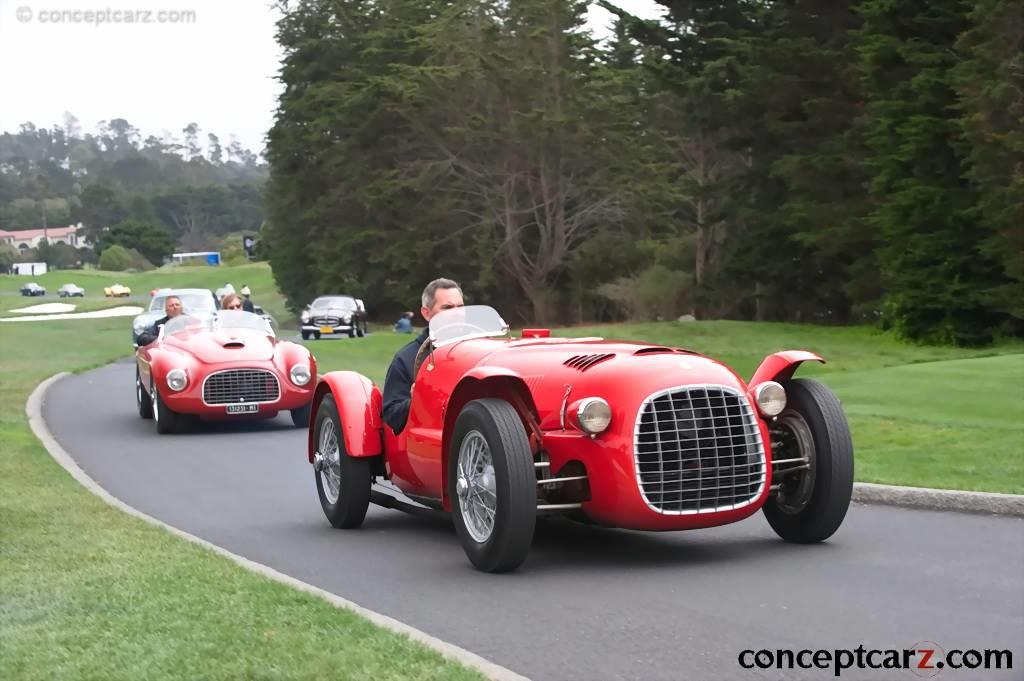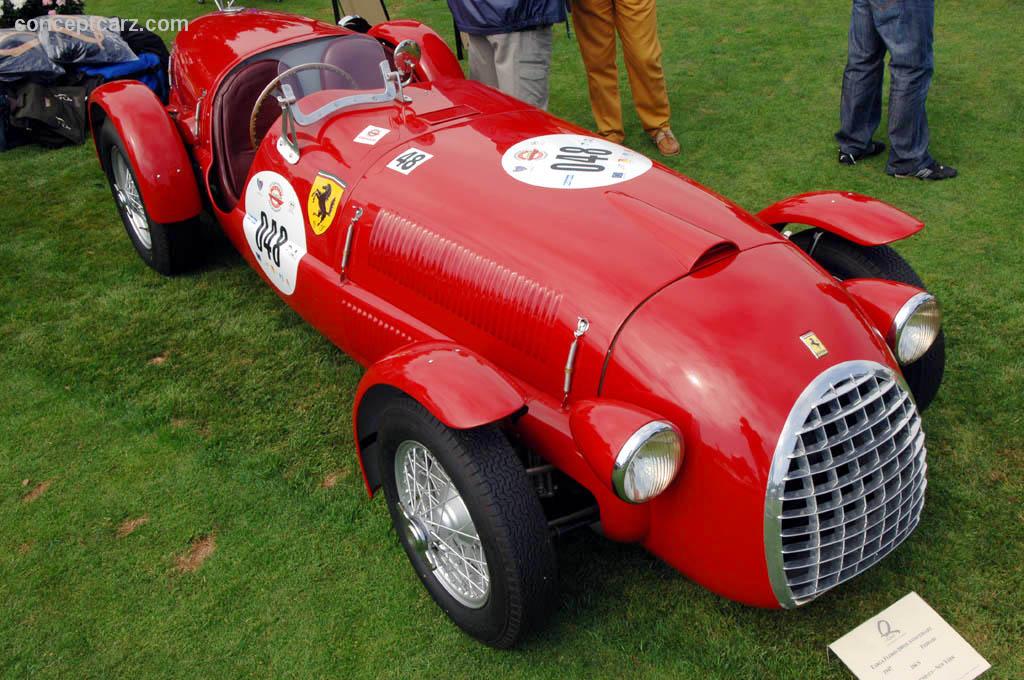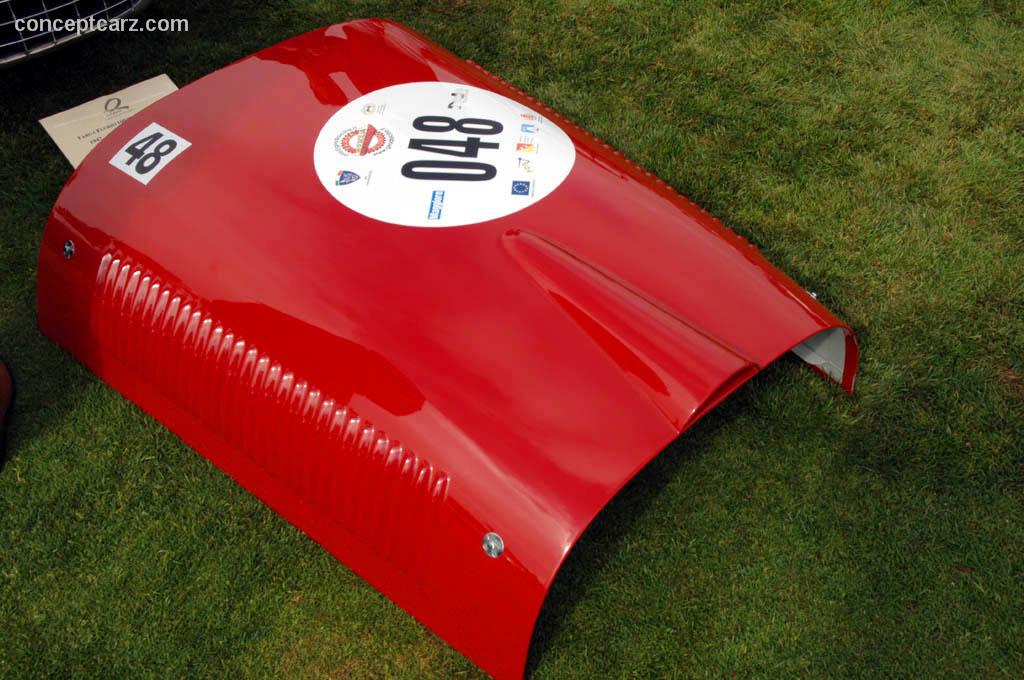The images shown are of a Ferrari 166 Spyder Corsa, chassis number 004C, only the second Corsa to be constructed. More importantly, it is believed to be the fourth Ferrari ever created. Out of the eight remaining Spyder Corsas that have survived to this date, chassis numbers 004C and 016I are still clothed in their original bodies. Meaning, they have been properly and painstakingly preserved rather than undergoing any restoration. The creation of the engine is believed to have begun in 1946. Since it has retained its original chassis and body, many Historians refer to 004C as the oldest complete Ferrari still in existence.
Spyder Corsa
Chassis #: 004C
View info and historyIn the early parts of its life, until the mid 1950s, it was actively campaigned at many sporting events. In modern times it is shown at various shows and events.The legacy of Ferrari begins with its owner, Enzo Ferrari, a highly competitive individual that began racing in the early 1920s. Near the close of the 1920's, he formed his own racing team, 'Scuderia Ferrari.' He had grown in success by assembling some of the greatest engineers and drivers available. Vittorio Jano, an engineering genius, joined Alfa Romeo in 1923 and immediately began a design program that would ultimately lead to the P2 Grand Prix cars. He was also responsible for the use of twin-cam engines in two series of the 6C cars. Vittorio Jano's 1929 6C 1750 had been a mechanical jewel with an enviable sporting record, dominating Sport Category racing until 1931. Then later, to maintain the firm's superiority, an eight-cylinder version of the same car, the 8C 2300 appeared. Tazio Nuvolari, one of the drivers for Scuderia Ferrari, captured many historic victories and propelled the cars he drove into the history books. In 1937 Enzo Ferrari decided to break his ties with Alfa Romeo and begin his own independent racing program. Since the relationship between Enzo Ferrari and Alfa Romeo was so closely knit, there were still contracts in place. To ensure that no issues would arise, such as stealing customers or using trade secrets, Enzo agreed not to create vehicles under his own name for a period of four years. He formed a company named Auto Avio Construzioni that created vehicles, only two were ever built, using Fiat components and costumed bodied by coachbuilders. The onset of World War II slowed and ultimately halted the production of automobiles. Instead, the factories and workers focused on creating military items to support the war efforts. 
Spyder Corsa
Chassis #: 004C
View info and historyAfter the war, there was still high demand for the items Enzo had been creating during the war. His passion was racing, and soon a new car was under construction. He began by employing Gioachino Colombo, an individual that would aid in the success of the Ferrari Empire. Colombo began by designing a chassis and drivetrain. The result was a tubular frame with a 12-cylinder 'Vee' type engine. This was not 'ground breaking,' but it was a proven design, having been used by Alfa Romeo in the past. The engine design would prove its worth and versatility by lasting until the mid-1960s, powering many road and track vehicles. Enzo had requested that a five-speed manual transaxle be matted to the 1.5-liter engine, a feature that would give his cars an advantage. A supercharger was added to comply with the Grand Prix regulations.Alfa Romeo saw the genius within Colombo and were able to steal him away from Ferrari. Enzo Ferrari was left with little; he had designs for the engine and chassis but no one to construct them. Aurelio Lampredi joined Ferrari in October of 1946 and began work on creating the engines. The chassis development was sent to Gilco, a company that could perform the work. By the close of 1946, Ferrari was advertising the sale of his 125, a name created from the unitary displacement of the 1.5-liter engine. By early 1947, the first car was assembled. Within a short period of time, they were being raced.
Spyder Corsa
Chassis #: 004C
View info and historyThe racing program fueled the development of even better racing cars. The bore and stroke of the V12 were enlarged to 1908 cc's, and the vehicles that housed these engines were named 159, in accordance with the Ferrari naming standard. Colombo returned to Ferrari and began modifying the 159 resulting in even more power and better performance. The bore and stroke were enlarged even further, resulting in the 166. The first 166 Spyder Corsa sold was actually a 159 that had been raced at the Turin Grand Prix where it had emerged victorious. It was sold at the close of 1947. The following year another seven cars were created. A short time thereafter, a 166 MM won the grueling and prestigious 24 Hours of LeMans. This victory proved the engine's endurance and the capabilities of the Ferrari-built automobiles. In a time when advertising of vehicles was rarely done; rather, the success of the manufacturer relied on the outcome of their racing programs. Ferrari, to this day, has proved to be one of the greatest manufacturers of supercars to this day. His competitive nature and desire to prove his machines have forever cemented his place in history. Chassis 004C is one of the oldest and purest examples to have survived. Enclosed under that long and flowing bonnet is a Colombo-designed engine. The entire body is a time capsule that has been delicately preserved and is now graciously shown at events for the public to admire.
by Daniel Vaughan | Feb 2006

Spyder Corsa
Chassis #: 004C
View info and history

Spyder Corsa
Chassis #: 004C
View info and history

Spyder Corsa
Chassis #: 004C
View info and history
by Daniel Vaughan | Feb 2006
Related Reading : Ferrari 166 Spyder Corsa History
The 166 Spyder Corsa was the first series of models offered by the newly formed Ferrari marque in 1947. Only eight were built, numbered 002C, 004C, 006C, 008C, and the 010I through 016I. The first cars sold to customers were 002C and 004C, which were sold to the Besana brothers, Gabriele and Soave, near the close of 1947. Chassis 006C, 010I, 0121, and 016I rested on a wheelbase that measured 95....
Continue Reading >>
Continue Reading >>
Related Reading : Ferrari 166 History
It was in 1948 when the newly formed Italian automobile company named Ferrari began selling a promising sports car named the 166. The two-seater sports car featured a 12-cylinder engine mounted in the front and supplying over 100 horsepower to the rear wheels. The engine was just under two-liters in size and had a unitary displacement of 166 cc, thus, the evolution of the model name. Production would....
Continue Reading >>
Continue Reading >>
Targa Florio VehiclesMille Miglia VehiclesSimilarly Sized Vehicles
Similar Vehicles
Similar Automakers
Similarly Sized Vehicles
from 1947
1947 Ferrari 166 Spyder Corsa Vehicle Profiles
Recent Vehicle Additions
Related Automotive News

Phenomenal Ferraris and Italian Thoroughbreds Offered at Gooding & Company's Pebble Beach Auctions
The auction house announced a stable of Italian star cars, including a 1950 Ferrari 166 MM Berlinetta Le Mans, a 1961 Ferrari 400 Superamerica Series I Coupe Aerodinamico, and a 1954 Ferrari 500 Mondial Series I Spider.
A stunning group of star...

Ex-Scuderia Ferrari Alfa Romeo 8C 2300 Monza Spider By Zagato Scoops Best Of Show At Salon Privé
Alfa Romeo 8C 2300 Monza Spider by Zagato raced by Tazio Nuvolari wins top award
Leading designers present inaugural Churchill Cup to rare Lancia Astura
Duke of Marlborough selects his favourites on two wheels and four
Record entry for the UKs...

Ferrari Museum Celebrates Scuderia Ferrari's Landmark Anniversary With The '90 Years Exhibition'
Hypercars the story of Ferraris technological evolution told through milestone cars
Maranello, xx May 2019 – One of the great iconic names in motorsport with the power to unite an entire country and millions of fans from all over the...

The Trident is Raised
One of Italys most famous marks, and perhaps most troubled, the trident-bearing automaker continues to provoke passion through its search of excellence.
Five brothers would come together in December of 1914 to found a motor company bearing their name—Maserati....

1982 German Grand Prix: Unfortunate Fortuity and Great Loss
On the podium at Imola in late-April of 1982, the look on Gilles Villeneuves face would speak volumes. Then there would be the tragic events at Zolder just a couple of weeks later. But while many would want to point fingers at Villeneuves teammate,...






























